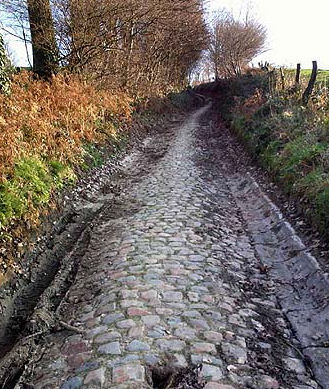Amazing as it might seem, the hardest cobbled sections of the Tour of Flanders and Paris-Roubaix were not “discovered” until the late 1960s/early 1970s. In other words, these crucial sections belong to the sport’s modern era and are not necessarily part of the glorious history of the sport.
The Koppenberg
Many would say the Koppenberg is the hardest berg of the Tour of Flanders. Not usually decisive as it’s not as close to the end of the race. But it was not introduced until 1976. Around this time Belgium was updating much of its road network, including tarmacking many cobbled climbs. So the hunt for hellingen was on.
The Koppenberg was merely a farm track, including a cobbled section. Because of its rough surface and steep slopes few used the route, as a result almost no one knew about it. It was thanks to Hubert Hoffman, a resident of Melden, who pointed out the road to race organisers and it was duly included in the race. But it was kept secret for some time by none other than Walter Goodefroot, winner of the Ronde in 1968 and 1978. He used it in training but did not want to tell others about the road, “I didn’t want to have this sort of climb in a race” he told L’Equipe.
Stablinski’s route to work
There’s a similar tale for Paris-Roubaix. France was upgrading its roads and cobbled sections were disappearing at an alarming rate. It’s worth noting that before the 1970s, many of the cobbled sections of the race were on main roads, the cobbles used in the race were fit for normal transport use and not the farm tracks that make Paris-Roubaix famous today.
Faced with the loss of cobbles, race organiser Jacques Goddet instructed his no.2 Albert Bouvet to find more cobbles, “go north and take your pilgrim’s staff” barked Goddet. Unsure – how can you magic cobbles out of nowhere – Goddet decided to consult a friend: Jean Stablinksi. Stablinski was the son of Polish immigrants who had moved to work in the coal mines of northern France. “Stab” himself worked in the mines for a while before turning professional – after winning a bicycle in an accordion music competition – and went on to win the Vuelta a Espana and the World Championships. Retired, he was rider with a good knowledge of the local roads. If anyone knew a few bonus sections of cobbles it would be Stablinksi.
Stablinski took Bouvet away from the traditional route, heading some 40km east. It was here that the former miner showed the race organiser the road past his old mine in the Arenberg forest, the now infamous Wallers-Arenberg section. Stablinski would work down in the mine but never rode past it when he became a cyclist, “too hard“.
Stablinksi later admitted to feeling guilty about telling the race organisers about this stretch of pavé and even the race organisers were concerned it would be too hard. After adding Arenberg and other nearby sections a worried Bouvet asked aloud “And what if nobody makes it to the finish?” a few days before the race. “So long as there is one rider” replied the stoic Goddet.
Indeed, come Sunday it was none other than Eddy Merckx who made it to Roubaix first, to claim his first win in the Hell of the North.



Brilliant, never knew that. Just goes to show that the Classics, although as old as the sun, are/were still evolving.